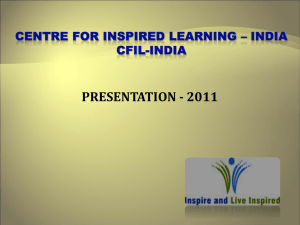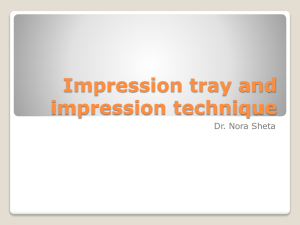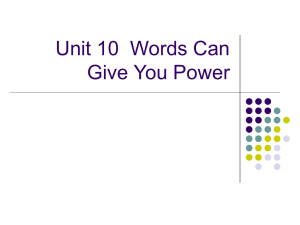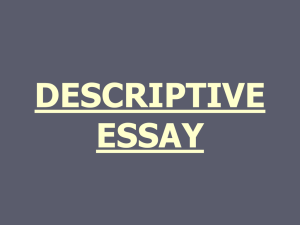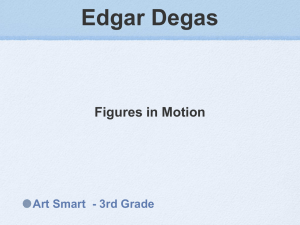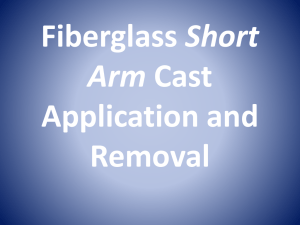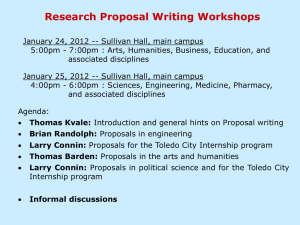impression materials and procedures for
advertisement
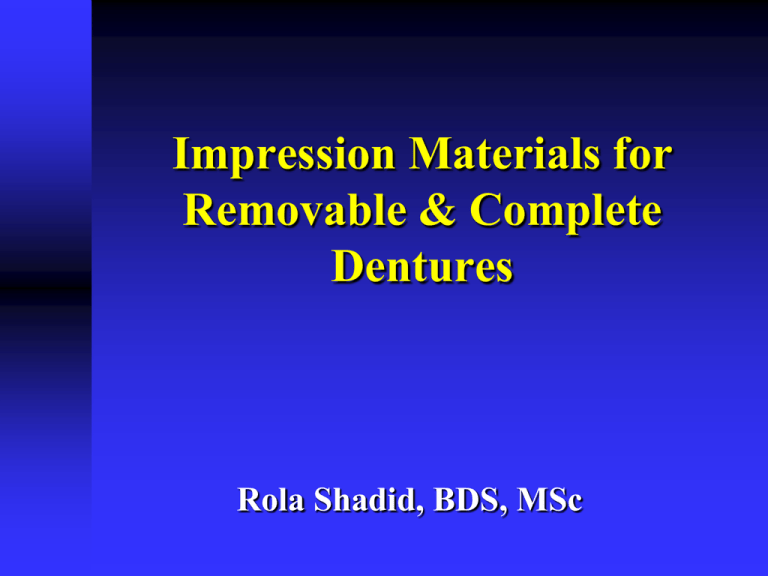
Impression Materials for Removable & Complete Dentures Rola Shadid, BDS, MSc Rigid Impression Materials Are those that set to a rigid consistency It is capable of recording tooth and tissue details accurately , they cannot be removed from the mouth without fracture and reassembly Plaster of Paris Plaster of paris was once the only material available for partial denture impression, but now elastic materials have replaced them used by many dentists to record maxillomandibular relationship Metallic Oxide Paste Metallic oxide paste is some form of a zinc oxide – eugenol combination Not used as primary impression materials , and not used for impressions that include remaining natural teeth Not used in stock tray Metallic Oxide Paste Border molding with metallic oxide impression pastes is not advisable because wrinkles will occur if movement is permitted at the time of setting All metallic oxides have a setting time during which they should not be disturbed and after which no further border molding is effective Metallic Oxide Paste Mixing time 30 to 45 secs Setting time 3 to 5 mins Brittle, messy, sometimes irritates patient due to eugenol content Metallic Oxide Paste Uses Secondary impression for complete denture Altered cast technique Relining distal extension denture bases Metallic Oxide Paste Thermoplastic Impression Material Are those that become plastic at higher temperature and resume their original form when cooled Modeling plastic It is manufactured in several different colors, each color being an indication of the temperature range at which the material is plastic and workable If modeling plastic is softened at a temperature above that intended by the manufacturer , the material becomes brittle and unpredictable , also there is the danger of burning patient's mouth Modeling plastic Forms 1. Red brown material in cake form 2. Red, gray, green modeling plastics in stick form Modeling plastic Used in border molding of impression tray The modeling plastic are used as a secondary impression material to record edentulous ridges in partial denture construction (building up the underside of the denture before recording the tissue with secondary impression material) Red brown material in cake form The most commonly used modeling plastic for corrected impressions of extension base areas for Kennedy Class I and II partial denture bases It should be dipped and kneaded until soft and subjected to no more heat than necessary before loading the tray and positioning it in the mouth, then it should be chilled in cold water after each removal from the mouth Red, gray, green modeling plastics in stick form Used in border molding of impression tray Red and gray sticks have a higher and broader working range than do the cake of like color The modeling plastic are used as a secondary impression material to record edentulous ridges in partial denture construction, when this is done it is generally used only as a mean of building up the underside of the denture before recording the tissue with secondary impression material Modeling Plastic (Compound) Impression waxes and natural resins They are mouth temperature waxes Iowa may be used as a secondary impression material or as impression material for relining Since mouth temperature waxes have the ability to flow as long as they are inside mouth they permit equalization of pressure and prevent over displacement of tissues Impression waxes and natural resins Impression waxes may be used to correct borders of impressions made of more rigid materials (useful for correction of small imperfection in ZnOE impression) Other type of waxes have more resinous base , they are used to record tissues under an occlusal load Resinous waxes are not ordinarily used in partial denture impression technique except for secondary impression for recording partial lower free end Elastic materials Are those that remain in an elastic or flexible state after they have set and have been removed from the mouth Hydrocolloids Reversible vs. irreversible hydrocolloids All hydrocolloids are dimensionally stable only during a brief period of time They are hydrophilic materials so can gain water and expand (imbibition), so must not be immersed in water They lose water rapidly and shrink if exposed to air Hydrocolloids The principal difference between reversible and irreversible hydrocolloids is that reversible hydrocolloid convert from the gel form to sol by application of heat , it may be revert to gel form while irreversible hydrocolloids become a gel via a chemical reaction and this change is irreversible Hydrocolloids They should be poured immediately no more than 15 minutes delay and stored during this period in a saturated atmosphere ( wrapping impression in a damp paper towel ) Hydrocolloids Hydrocolloids exhibit a phenomenon known as syneresis , which is associated with the giving off a mucinous exudates that will affect the gypsum material and produce soft or chalky cast surface This can be prevented by pouring the cast immediately and using some chemical accelerators as potassium sulfate * Irreversible hydrocolloids (Alginate) * Used for making diagnostic casts, orthodontic treatment casts, master casts for removable partial denture Advantages of Alginate Pour well with stone Pleasant taste , odor , nontoxic , nonstaining and inexpensive Disadvantages of Alginate Low tear strength Provide less surface details than other materials Not dimensionally stable Disadvantages of Alginate Gelation reaction takes place next to the tissues and any movement of the tray during setting will result in internal stresses that will cause impression distortion It must be introduced to the mouth at approximately 70 F which result in an immediate increase in the viscosity and surface tension , air bubbles are harder to dispel and so more air will be trapped than in a reversible impression. Precautions to be Observed in the Handling of Hydrocolloid Impressions Should not be exposed to air Should not be immersed in water Mucinous exudate has a retarding effect on the chemical reaction of gypsum products * Should be protected from dehydration by placing it in a humid atmosphere or wrapping in a damp paper towel Mercaptan rubber – base impression materials (Polysulfide, Thiokol) It can be used for RPD impressions especially for altered cast technique or secondary impression To be accurate the impression must have a uniform thickness that does not exceed 3mm Mercaptan rubber – base Materials that are highly cross_ linked (medium and heavy body ) do not recover well from deformation and should not be used in large multiple undercuts The long term dimensional stability is poor because of water loss It should be left for 7 to 15 minutes to rebound from deformation after it is removed from mouth Mercaptan rubber – base High tear strength Long working , setting time (8 to 10 minutes) Because of long setting time they lend themselves better to border molding in adequate supporting trays more than hydrocolloids Mercaptan rubber – base Mercaptan rubber – base Polyether impression materials Excellent accuracy and wetting Good dimensional stability Very good shelf life (~ 5years, less in warm conditions) Thixotropic * Polyether impression materials Low to moderate tear strength Flexibility is the lowest of any of the elastic impression materials, this limits its use in RPD impressions Shorter working time than PVS silicones Stiff material may lead to breakage of cast on removal of cast from impression Unpleasant taste Higher permanent deformation than polyvinyl siloxanes Polyether impression materials Polyether impression materials are not compatible with polyvinyl siloxane, so should not be used with polyvinyl siloxane custom tray The material absorb water, must not be stored in water Polyether impression materials The material should be poured within 2 hours; but if they are kept dry, acceptable casts can be poured within 7 days Polyether impression materials Silicone impression materials There are two types of silicone impression material : Condensation silicones ( polysiloxanes ) Addition reaction silicones (polyvinyl siloxanes) Condensation silicones ( polysiloxanes ) 5 to 7 minutes working time that can be altered by adjusting the amount of accelerator Pleasant odor High tear strength Excellent recovery from deformation Should be poured within 1-2 hours Addition reaction silicones ( polyvinyl siloxanes ) Can be poured within up to 1 week Thixotropic Sulfur in latex gloves and in ferric and aluminum sulfate retraction solution may inhibit polymerization Available in hydrophilic and hydrophobic forms Addition reaction silicones ( polyvinyl siloxanes ) The working time 3 to 5 minutes , can be adjusted with the use of retarders and temperature control Addition reaction silicones ( polyvinyl siloxanes ) hydrophobic can make cast formation a problem More expensive than other elastic impression materials Addition reaction silicones The most accurate of the elastic impression material Less polymerization shrinkage Low distortion, fast recovery from deformation High tear strength No smell, no taste Step-by-step Procedure for Making Alginate Impression Tray Selection Large enough with 5mm of clearance to provide a 4- to 5-mm thickness of impression material between the teeth & tissue, & the tray Hydrocolloid requires bulk for accuracy, strength and stability Build up the palatal portion of the maxillary impression tray with wax or modeling plastic * Material can be syringed into the palate Smooth with a finger, or voids may occur The lingual flange of the mandibular tray may need to be lengthened with wax in the retromylohyoid area or to be extended posteriorly, but it rarely ever needs to be lengthened elsewhere Place the measured amount of water (at 70° F) in a clean, dry, rubber mixing bowl (600-ml capacity). Add the correct measure of powder Stir rapidly against the side of the bowl with a short, stiff spatula. This should be accomplished in less than 1 minute. Place the patient in an upright position, with the arch to be impressed nearly parallel to the floor. Ask the patient to rinse his or her mouth with cool water to eliminate excess saliva while the impression material is being mixed and the tray is being loaded. After loading the tray, remove the gauze with the topical anesthetic and quickly place (rub) some of the impression material on any critical areas using your finger (areas such as rest preparations and abutment teeth). Place the anterior portion of the tray first, then seat the posterior of the tray Mold the vestibular area Pull on the cheeks and lips to activate muscles and frena Support the tray during setting - do not leave the patient Movement causes distortion * Once seal broken, remove quickly (to avoid permanent deformation) Evaluate impression Pour within 15 minutes Rinse thoroughly with water Gently shake to remove excess water Spray with disinfectant to coat all surfaces, and seal in a bag for 15 minutes Common Pitfalls and Solutions in Impression Making Common Pitfalls and Solutions in Impression Making Common Pitfalls and Solutions in Impression Making Common Pitfalls and Solutions in Impression Making Common Pitfalls and Solutions in Impression Making Common Pitfalls and Solutions in Impression Making Pitfall: Removing tray improperly. Solution: Don’t use handle, and break suction over premolar area and pull tray down. Reference: Impression taking: common pitfalls and solutions. Oct 28, 2011 By Hollie Bryant, DA II Pouring a Model A more abrasive resistant Type IV stone should be used to form removable partial denture casts. Casts should be a minimum of 16-18 mm in thinnest part Separate the alginate impression from the stone cast after 30 minutes * Trimming Casts Trim the base on the model trimmer parallel to the residual ridges Leave the vestibular reflection intact for making a custom tray Trimming Casts All anatomical surfaces should be included with minimum voids Possible Causes of an Inaccurate and/or a Weak Cast of a Dental Arch 1. Distortion of the hydrocolloid impression (a) by use of an impression tray that is not rigid; (b) by partial dislodgment from the tray; (c) by shrinkage caused by dehydration; (d) by expansion caused by imbibition Possible Causes of an Inaccurate and/or a Weak Cast of a Dental Arch 2. A ratio of water to powder that is too high. Although this may not cause volumetric changes in the size of the cast, it will result in a weak cast. 3. Improper mixing. This also results in a weak cast or one with a chalky surface. 4. Trapping of air, either in the mix or in pouring, because of insufficient vibration. Possible Causes of an Inaccurate and/or a Weak Cast of a Dental Arch 5. Soft or chalky cast surface that results from the retarding action of the hydrocolloid or the absorption of necessary water for crystallization by the dehydrating hydrocolloid. 6. Premature separation of the cast from the impression. 7. Failure to separate the cast from the impression for an extended period. Individual Impression Trays for Making Alginate Secondary Impression Adapt one layer of baseplate wax over the tissue surfaces and teeth of the cast to serve as a spacer for impression material The wax spacer should be trimmed 2 to 3 mm short of the outline drawn The posterior palatal seal region is not covered by wax but will be included in finished tray * Adapt an additional layer of baseplate wax over the teeth if the impression is to be made in irreversible hydrocolloid. This step is not necessary if the choice of impression material is a rubber-base or silicone type of material. A window is created in wax spacer over incisal edges acting as anterior stop * Holes are drilled through tray, spaced approximately 5 mm apart.* These holes will serve to lock impression material in tray. In addition, excess impression material is forced out of holes when impression is made, thereby minimally displacing soft oral tissues. * The technique for making an individual mandibular resin tray follows the same procedures. The wax spacer does not cover the buccal shelf regions, because these areas provide the primary support for the mandibular removable partial denture and serve as posterior stops in orienting the tray in the patient's mouth.* Final impressions for maxillary toothsupported removable partial dentures often may be made in carefully selected and recontoured rigid stock impression trays. An individual acrylic resin tray is preferred in those situations in the mandibular arch when the floor of the mouth closely approximates the lingual gingiva of remaining anterior teeth. Recording the floor of the mouth at the elevation it assumes is important in selecting the type of major connector to be used Impression Materials for the Partially Edentulous Arch Materials that could be permanently deformed by removal from teeth or tissue undercuts should not be used, these include *: • Thermoplastic impression materials, • Rigid impression materials, • Rubber base materials that are highly cross-linked when large or multiple undercuts exist Impression Materials for the Partially Edentulous Arch The final anatomic (one-stage) impression usually will be made with irreversible hydrocolloid, mercaptan rubber, or silicone impression materials. Use irreversible hydrocolloid (alginate) for one-piece final References McCracken's Removable Partial Prosthodontics, Impression Materials and Procedures for Removable Partial Dentures What Happens if One-stage Anatomic Impression Tech. is Made for Distal Extension RPD? A distal extension RPD fabricated from a one stage impression which only records the anatomic form of basal seat tissue, places more of the masticatory load on the abutment teeth and that part of the bone that underlies the distal end of the extension base. * What Types of Impression Techniques Should be Made for Distal Extension RPD? 1. Functional impression tech. 2. Selective pressure "dynamic" impression technique * How could you make selective pressure "dynamic" impression technique? By fabricating a specially designed individual tray, you could control the flow of impression material by: o Amount of wax relief o Venting Impression Tech. for Distal Extension Bases (Mandibular) Since the goal is to maximize soft tissue support and also use teeth to their supportive advantage, a secondary impression (selective pressure) made in custom trays attached to the framework is a means to coordinate both (Altered cast tech) * Altered Cast Technique Altered Cast Technique Corrected Cast Modified Cast Altered Cast Impressions Impression of residual ridge Custom impression tray attached to the framework Purpose Provide maximum support for distal extens.RPD More accurate relationship between abutments & ridge Equalize stress between ridge & abutments Minimize tissueward movement of distal extension base Maintain occlusal contact between both natural & artificial dentition Correct peripheral adaptation When Needed? Class I & II - relationship most needed Extensive Class III & IV cases Tooth mobility + compressible mucosa Less necessary in maxilla Procedure 1. Well Fitting Framework 2. Place relief over ridge 1 mm wax relief Heat and fully seat the framework 3. Separator (Tinfoil substitute (Alcote) or model release agent) +Acrylic tray adaptation 4. Check Seating If not seated, remove, repeat Rests fully seated Tissue stop contacts cast Metal adjacent abutment contacts cast No resistance as framework seated 5. Check Peripheries 2-3 mm short of vestibule No displacement when: Pull on cheeks, lips Patient activates tongue 6. Border Mold Simulate final denture border 7. Make Altered Cast Impression Ensure tray is well retained by framework Remove wax spacer Coat tray with adhesive If you want to make impression with addition silicone Altered Cast Impression Material Polyvinyl siloxane (Light or medium body) OR Metallic oxide paste impression material Carefully load tray No material under rests, guiding planes, max. major connector, etc. Seat with pressure over Rests No Pressure Over Gridwork Fulcruming or tissue compression Spring back and lack of tissue contact 8. Remove & Inspect Impression Absence of voids Minimal burnthrough Covers supporting tissues Fully seated, etc. 9. Send to Laboratory Lab Steps Section residual ridge from cast Ensure no contact between impression & cast Place retentive grooves in cast Sticky wax in place Lab Steps Box impression Ensure water tight seal Seal retainer, major & minor connector borders Pour new ridge areas in different color stone Pour new ridge areas in different color stone Problems with the Altered Cast Technique If tray is added carelessly, it can alter passive relationship Excess impression material under framework If inadequately sealed, stone over teeth, can’t articulate model Why is the altered cast method most commonly used for mandibular distal extension RPD not for maxillary? Why is the altered cast method seldom used in the maxillary arch? Record Base for Wax Setup Place Denture Base Hard baseplate wax Easier to remove during processing Can melt or distort Acrylic resin Harder to remove More rigid and stable for jaw relation Jaw Relation Records Mount Casts on Articulators Centric Record Maxilla to mandible position Protrusive Record Program articulator for excursions References McCracken’s Removable Prosthodontics, 11th Edition 2005 by McGivney GP, Carr AB. Chapter 16 Dalhousie continual education Support for the Distal Extension Denture Base Factors Influencing Support of the Distal Extension Base 1. Contour and quality of the residual ridge 2. Extent of residual ridge coverage by the denture base 3. Type and accuracy of the impression registration 4. Accuracy of the fit of the denture base 5. Design of RPD framework 6. Total occlusal load applied Contour and Quality of the Residual Ridge (Mandibular) Contour and Quality of the Residual Ridge (Maxillary) Contour and Quality of the Residual Ridge The immediate crest of the bone of the maxillary residual ridge may consist primarily of cancellous bone. Unlike in the mandible, oral tissue that overlies the maxillary residual alveolar bone is usually of a firm, dense nature (similar to the mucosa of the hard palate) or can be surgically prepared to support a denture base. Extent of Residual Ridge Coverage by the Denture Base Design of RPD Framework Mesial Rest Concept Provides axis of rotation that directs applied forces in more vertical direction so more of residual ridge receives vertically directed occlusal forces to support denture base Will tend to tip terminal abutment tooth mesially & thus be reinforced by other adjacent teeth Total Occlusal Load Applied The number of artificial teeth, the width of their occlusal surfaces, and their occlusal efficiency influence the total occlusal load applied to RPD Kaires concluded "the reduction of the size of the occlusal table reduces the vertical and horizontal forces that act on RPD & lessens the stress on the abutment teeth & supporting tissue Total Occlusal Load Applied Type and Accuracy of the Impression Registration Comparison of anatomic and functional ridge forms. Original mandibular cast showing left residual ridge area recorded in its anatomic form. Buccal shelf region is outlined. Right: same cast after left residual ridge area has been repoured to its functional form as recorded by secondary impression. Functional form is less irreqular * References McCracken’s Removable Prosthodontics, 11th Edition 2005 by McGivney GP, Carr AB. Chapter 16
